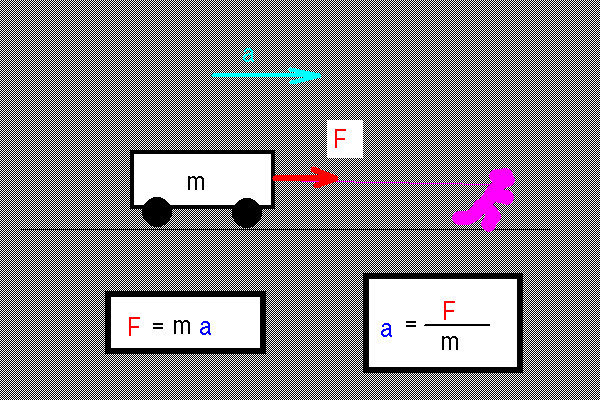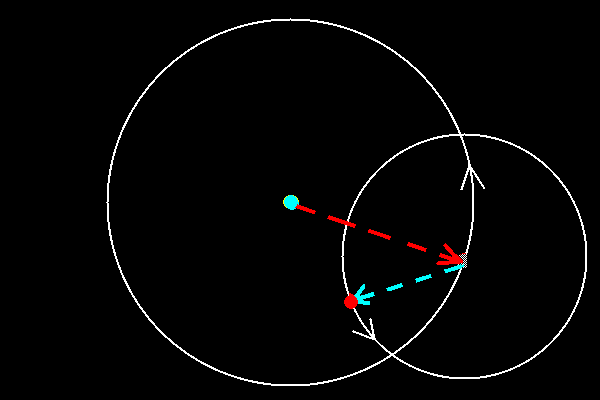Closing thoughts
In exploring the solar system, we have learned a bit of basic science.
- Kepler's three laws for planet orbits. In particular, we used the third
law to relate the period P of a planet to the radius
a of its orbit: if we measure P in years and a
in AU then

- Newton's three laws of motion. In particular, the second law is

- Newton's law of gravity:

- Observations of a moon going around a planet or a spacecraft going near it,
together with the law of gravity, can be used to determine the mass of the planet or other body.
- From the mass M of a planet or moon and its radius r, we
can compute its density. If we measure everything relative to the earth, the
formula is simple:

where ME is the mass of the earth,
where RE is the radius of the earth,
and (density)E is the density of the earth. Then
the density tells us something what the planet is made out of.
- From the mass and radius, we can also comute the square of the
escape velocity from the planet's surface:

This can tell us how well the planet could hold an atmosphere.
- Radiometric dating is based on the decay of radioactive nuclei. If
nucleus A decays to nucleus B with a half life T,
then after a time T, half of the A nuclei are left; after
a time 2T, 1/4 of the A nuclei are left etc..
- Gravity pulls everything together.
- Gas pressure can resist the pull of gravity and stabalize a ball of gas.
- The hotter the gas, the bigger the pressure.
- Compression of the gas makes it hotter.
- In a star, nuclear reactions make it very hot inside.
- Stuff in orbit around a central heavy body is also stable, as long as
the orbits don't intersect
- If there is lots of stuff, the way to do this is to have each piece
orbiting in its own circular orbit in a disk.
- In a self-gravitating ball of fluid, the dense stuff sinks, the
light stuff floats.
- Tidal forces are often important. Consider, say,
a moon of Jupiter. The gravitational force from Jupiter on the near side
of the moon is greater than average, while the force on the far side is
less than average. This difference is the tidal force, which tends to
distort the shape of the moon.
- Heat can move from one place to another by convection, conduction, or
radiation.
- Convection is important for the motions in the atmosphere of, for instance,
the earth and Jupiter.
- Convection also transfers heat from the middle of the earth and the
surface, thus generating plate tectonics.
- Radiation transfers energy from the sun to the planets.
- The earth radiates away the energy it gets from the sun. The so-called greenhouse gases interfere with this. (The same holds for Venus.)
- The rotation of the earth has a big effect on the motion of the atmosphere,
bending the path of air clockwise in the northern hemisphere. The same holds for Jupiter.
- Planets get magnetic fields when they have convection currents in
an electrically conducting fluid and the currents are bent by the rotation
effect. (Eg. the iron core of Earth, the liquid metallic hydrogen center
of Jupiter.)
Before the Renaissance, people didn't know any of this. However, astronomers
of the Greek and Hellenistic civilizations made great progress in learning
what is happening in the sky.
- Astronomers didn't know if the same rules that apply on Earth should
apply in the heavens.
- They guessed ``no.''
- In any case, they didn't have too much right about the laws on Earth.
- This situation didn't change until Galileo and Newton and their contemporaries.
- The simple questions of where things are and how they are moving were
central.
- Astronomers didn't know whether to put the earth at the center or
the sun at the center.
- They mostly guessed ``earth-centered.''
- This situation didn't change until Copernicus.
The available data are the motions of the sun, moon, planets, and stars on the sky. We learned how to figure out what these motions should be based on
- the rotation of the earth once per day
- the orbital motion of the earth about the sun once per year
- the tilt of the earth's rotation axis relative to the plane of the
ecliptic
- the motion of the planets about the sun, with periods less than a year
for Mercury and Venus and with periods of greater than a year for Mars, Jupiter, and Saturn (and Uranus, Neptune and Pluto).
Two ideas help with this.
- We can think of viewing the sky once per day when the same star is
overhead.
- Then we think of the
celestial sphere with the stars fixed on it.
- We can plot the positions of the sun, moon, and planets on the
celestial sphere.
- The sun, moon, and planets move on the
celestial sphere as the earth orbits the sun, the moon orbits the earth,
and the planets orbit the sun.
- Based on the orbits of Earth and a planet about the sun, we can
plot the path of the planet relative to the earth. This is pretty
straightforward for Mercury or
Venus, a but more subtle for
Mars, Jupiter, or Saturn. (We make the simplifying assumption
that the orbits are all circles.)

The net result of the analysis (2) above is that, relative to the earth,
the planets move about a little circle, the center of which moves about
a big circle whose center is the earth.
There were lots of steps in the development of Greek and Hellenistic
astronomy. The culmination was the theory of Ptolemy. There were some
complicating features, but the basic idea was that
the planets move about a little circle, the center of which moves about
a big circle whose center is the earth.
There is a famous quote of Isaac Newton in a letter to Robert Hooke, February 5, 1675:
If I have seen further [than certain other men], it is by standing upon
the shoulders of giants.
Surely Ptolemy was one of those giants.
ASTR 121 Home
Davison E. Soper, Institute of Theoretical Science,
University of Oregon, Eugene OR 97403 USA
soper@bovine.uoregon.edu





